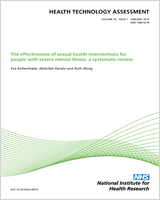NCBI Bookshelf. A service of the National Library of Medicine, National Institutes of Health.
Cook JA, Julious SA, Sones W, et al. Practical help for specifying the target difference in sample size calculations for RCTs: the DELTA2 five-stage study, including a workshop. Southampton (UK): NIHR Journals Library; 2019 Oct. (Health Technology Assessment, No. 23.60.)

Practical help for specifying the target difference in sample size calculations for RCTs: the DELTA2 five-stage study, including a workshop.
Show detailsSummary
Researchers are faced with a number of decisions when designing a RCT, the most important of which are the choice of trial design, primary outcome and sample size. The last is largely driven by the choice of the target difference for the primary outcome, although other aspects of sample size determination also contribute. It is important to be explicit and transparent about the rationale for and justification of the target difference when undertaking a sample size calculation and subsequently reporting it. The target difference, if well chosen, can be used in the interpretation of the trial results.
The DELTA2 advice and recommendations on specifying a target difference for a RCT has been developed in response to a recognition that there is a need for practical advice to inform its choice. It was developed by a multidisciplinary group and was informed by multiple stages of preliminary work (see Appendix 1 for further details). This new document aims to address this need, and has used real-world case studies to illustrate how the target difference was chosen in clinical trials and to illustrate how the sample size calculation can be reported. It is intended to be of help to individual researchers and accessible to all relevant stakeholder groups. Engagement with funders is planned to maximise the potential value and usefulness to specific stakeholders. For the document to have the most impact, in terms of raising awareness of alternative approaches, the following would be beneficial: encouraging good practice in undertaking and reporting the sample size calculation, and endorsement from journals, funders of randomised trials and relevant professional groups.
Further research priorities
Producing corresponding recommendations for practice and reporting items for atypical sample size calculations, such as those that are simulation based due to their complexity, and studies that utilise an alternative statistical framework (such as Bayesian and/or decision theoretical) are needed to facilitate greater use of these methods.
Developing complementary recommendations for practice and reporting items that extend the work to cover additional alternative trial designs (e.g. multiarm, multistage, umbrella), which have not been explicitly covered.
- Conclusions - Practical help for specifying the target difference in sample size...Conclusions - Practical help for specifying the target difference in sample size calculations for RCTs: the DELTA2 five-stage study, including a workshop
- Health economics - Exercise to prevent shoulder problems after breast cancer sur...Health economics - Exercise to prevent shoulder problems after breast cancer surgery: the PROSPER RCT
- List of abbreviations - Coenzyme Q10 to manage chronic heart failure with a redu...List of abbreviations - Coenzyme Q10 to manage chronic heart failure with a reduced ejection fraction: a systematic review and economic evaluation
- Independent economic assessment - Enzyme-linked immunosorbent assays for monitor...Independent economic assessment - Enzyme-linked immunosorbent assays for monitoring TNF-alpha inhibitors and antibody levels in people with rheumatoid arthritis: a systematic review and economic evaluation
- Discussion - Sixteen-week versus standard eight-week prednisolone therapy for ch...Discussion - Sixteen-week versus standard eight-week prednisolone therapy for childhood nephrotic syndrome: the PREDNOS RCT
Your browsing activity is empty.
Activity recording is turned off.
See more...